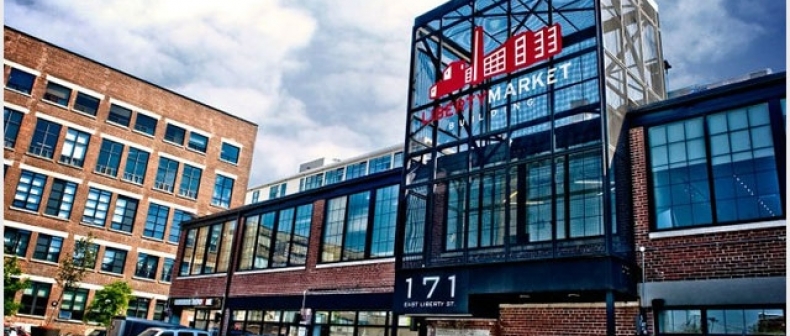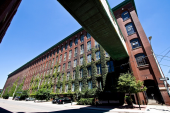
A few weeks ago, local residents arriving at their neighbourhood gym deep in the heart of Liberty Village got the news. In a note stuck on a door, Lifetime Developments announced their plans for a new project that would involve tearing down parts of the Liberty Market Building. The structure, a former armaments factory, is more than 100 years old, and tenant eviction means groups such as the fitness centre that had 1200 members and the 75-year-old Model Railroad Club of Toronto have to go. According to resident Sam Papaleo, the building was a meeting place for Liberty Villagers. It was an extended version of the Brazenhead Pub which is just down the road. Now, he and a handful of passionate locals are fighting to save the building.
“You lose a community meeting place which is important to people living in that particular neighbourhood,” Papaleo said. “The Liberty Market building was where everyone caught up. But now we must fight to save it.” Letters have been sent to area Councillor Mike Layton asking to save the building. Papaleo says they’ve gathered support on Facebook and have circulated a digital petition. Next, they’ll be hitting the pavement to gather more signatures.
Just about every neighbourhood across the city will, at some point will have their own Liberty Market Building situation at some point. With development skyrocketing across the city, structures that mean something to residents are only going to be torn down more frequently. Postal Station K near Yonge and Eglinton was a recent building that provoked a strong community response. In an effort to save the building, one man stood out the front of that building all summer long collecting signatures for a petition. He collected 10,000 names. Also, last year Downsview’s Air and Space Museum became an ice-rink. At the time, the museum CEO Robert Cohen told Toronto Star. “I can’t leave this place. I’m camping here. They’re gonna have to throw me out.”
Gauging the responses from recent examples, community activism is set to increase. The problem, though, for residents is that there is no clear-cut process for them to save a building or at least have the opportunity to try. As Papaleo said, “It’s like we are fumbling around in the dark. We are not activists.” Apart from letters and petitions (and let’s be honest, how much impact does that really have?) how can residents make an impact? Unless a building is designated under the Ontario Heritage Act, these Toronto neighbourhood landmarks will be at the mercy of developers; even if the building is 100-years old and serves a purpose to the community. In order for a building to be designated (i.e. “saved”), Scott Barret from Toronto Heritage Services who works on property evaluations and listings said it has to be first nominated either by a city councilor, community group or member of the public. Once nominated, Toronto Heritage Services then evaluates the property in accordance to a criteria set by the province. That information is then passed to the Heritage board and then voted on by city council. It’s worth mentioning too, Barret said, the number of nominations from the public have increased in recent times. “There’s definitely a growing interest,” he said.
But what if residents had the opportunity to buy a building that was slated for demolition by a developer? After some searching, I came across a possible solution: our own Localism Act. The Localism Act is a British law that gives community groups time — valuable time — to prepare a bid so they can purchase the asset either via a suitable investor, buying it as a co-operative or even time to crowd fund it. As it stands, Barret said there is currently no legislation or policy that allows such an application to be looked at by Heritage Services. “I’m sure there are models of that kind that could be looked at,” he said. Chapter Three of the Localism Act says residents submit a proposal to their local council in order to have the building listed as an “asset of community value.” The council can approve the listing if it believes the use of the structure “furthers the social wellbeing or social interests of the local community,” and is likely to continue to do so. We don’t need to cut and paste the British act into our city, but it’s worth considering and developing a Toronto “local” act, one that would give our citizens a clear process and the right to save a building at a municipal level.
Catherine Nasmith, architect and President of the Toronto Architectural Conservancy, helped develop a checklist here for anyone seeking a step-by-step playbook on how to go about saving a city building. Nasmith says that aside from getting a building designated through the Heritage Act, there’s not a whole lot — right now — community activist groups can do.
“We need grant allocation to save these types of buildings. At the moment we don’t have a financial incentive. Now the burden is on the private owner,” she said. “A Localism Act is an interesting idea. But, I also think we need to focus on putting an end to demolition. We need to stop trying to prove a building has cultural worth when it clearly has utility.”
It’s worth making note too, that development across the city is necessary at this point. The Greater Toronto Area’s population is expected to reach 7.45 million by 2031. So we need to develop, but where and how needs more thought. If you take a look at Chicago’s waterfront development, they’ve come up with the right mix: old and new, tall and mid-rises, gaps between buildings that doesn’t affect sunlight. There’s a balance there without high-rises taking over and strangling some of the aging buildings. But with more than 140 developments in progress, density is what Toronto’s future will look like and is where our own unique local act could come into play, not only for a voice for residents, but to protect aging yet functional buildings not designated under the Heritage Act.
Throughout the summer, National Post editor Maryam Siddiqi conducted a “Game of Hoods” poll which sparked furious debate over which local nooks were the best. Here’s a fact: we care about our neighbourhoods; we brag about them. We go berserk when someone slags our favourite coffee shop or burger joint. On the flipside, we are proud as punch when our neighbourhood gets voted the best for fine dining or gets nominated for best local watering hole. It only makes sense to have a local act that would give our communities a voice and a right to keep intact specific landmark buildings that gives a neighbourhood its character. If we lose our local aesthetics, how will each neighbourhood differ from each other in the future?
Correction: A previously published version of this article incorrectly listed Catherine Nasmith’s title as President of The Architectural Conservancy of Ontario, Toronto Branch. We regret the error.
____
Justin Robertson is a freelance journalist from Toronto. His work has appeared in The Walrus, National Post and Toronto Standard. Follow Justin on Twitter @justinjourno
For more, follow us on Twitter @TorontoStandard and subscribe to our newsletter.














